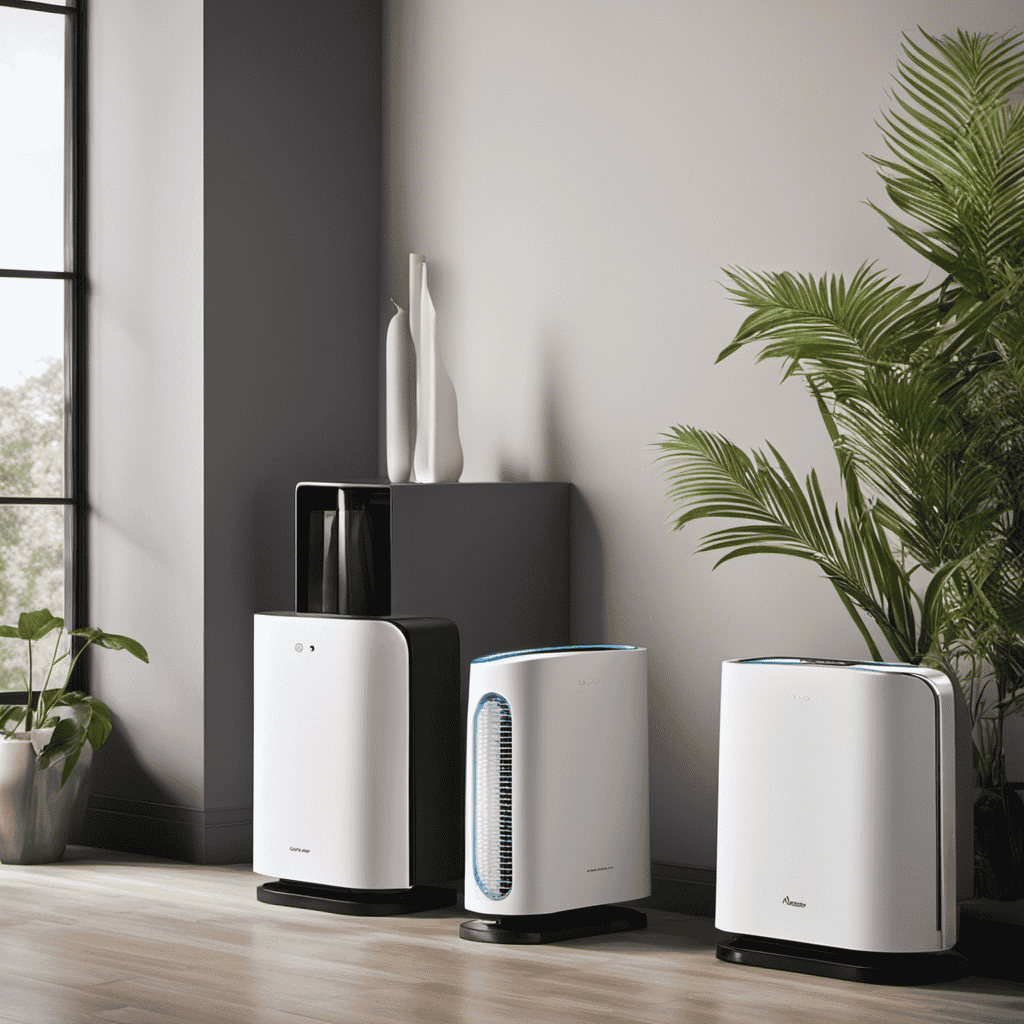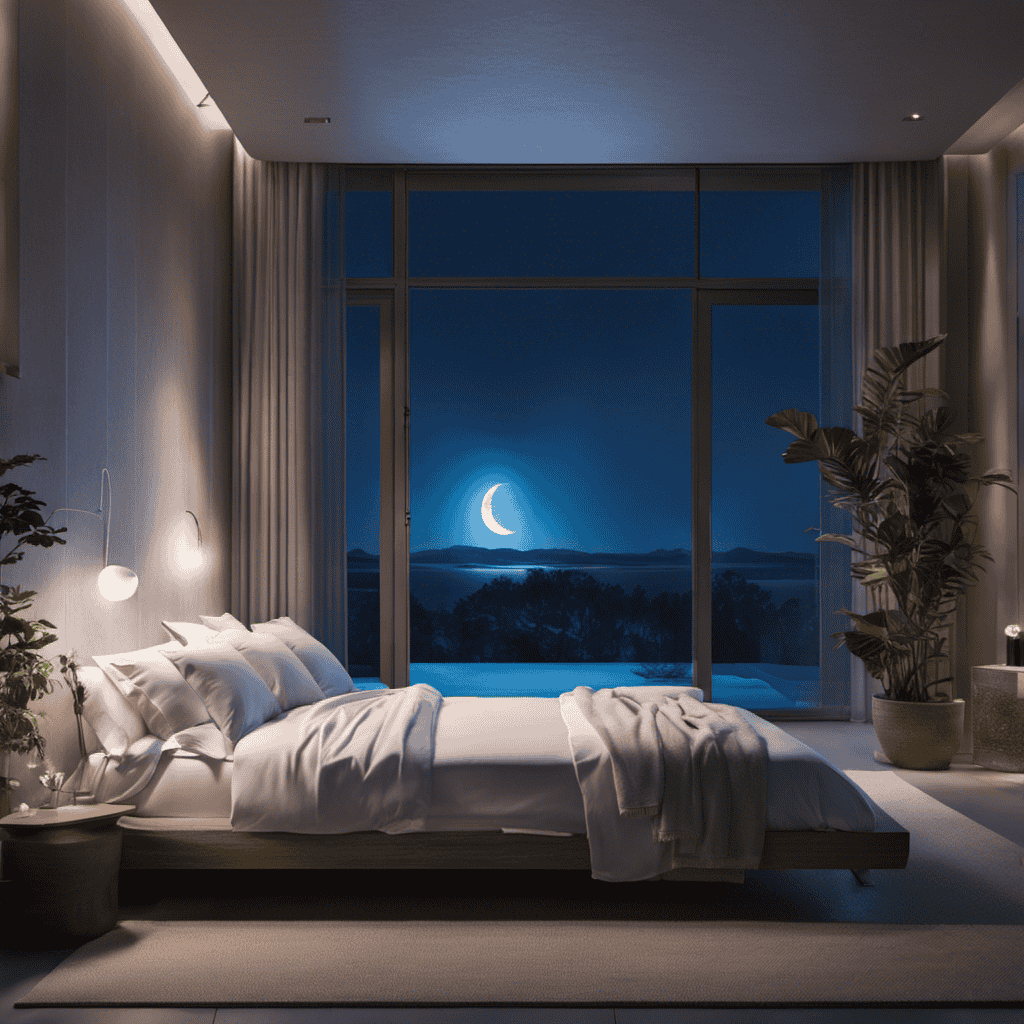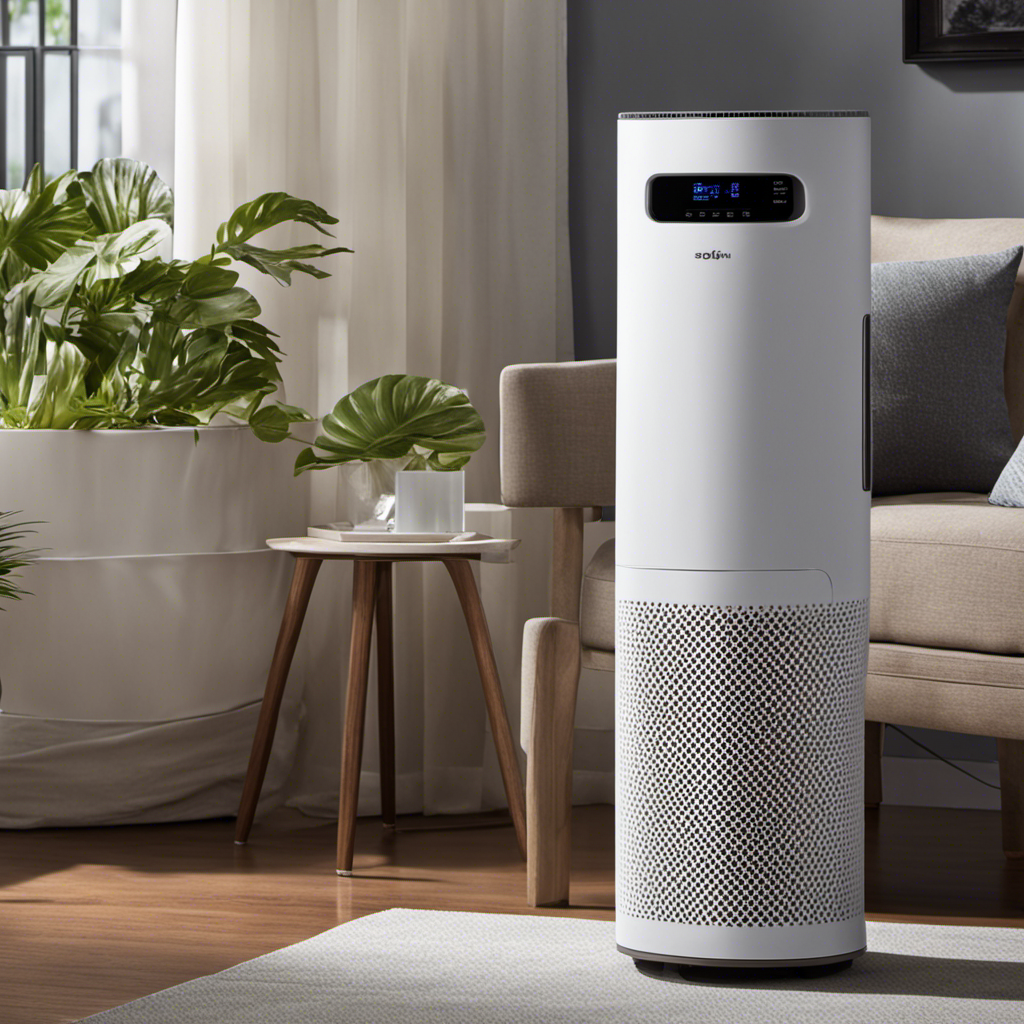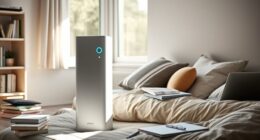As a person who prioritizes having clean and fresh air in my home, I frequently ponder whether an air purifier or a diffuser would be the optimal option.
In this article, we will delve into the key differences between these two devices, weighing the pros and cons of each.
By understanding how air purifiers and diffusers work, we can make an informed decision on which one suits our needs best.
So, let’s dive in and unravel the mystery of which is better: the air purifier or the diffuser.
Key Takeaways
- Air purifiers focus on improving air quality and reducing the risk of respiratory problems and allergies, while diffusers enhance ambiance and offer aromatherapy benefits for relaxation and stress relief.
- Air purifiers remove airborne particles like dust, pollen, and pet dander, reduce odors, and eliminate harmful pollutants like smoke and mold spores. They also improve sleep quality and overall respiratory health, benefiting individuals with allergies, and providing significant health benefits.
- However, air purifiers can be noisy and disrupt sleep for some individuals, and certain types require regular filter replacements, which can be costly.
- Diffusers offer aromatherapy benefits, act as a natural air freshener, provide health benefits through essential oils with antimicrobial properties, and allow for customizable scent combinations. However, there can be potential allergies and sensitivities, dilution is required to avoid skin irritation, safety precautions are needed for pets and ingestion, and high-quality oils can be costly.
Key Differences Between Air Purifiers and Diffusers
There’s a few key differences between air purifiers and diffusers that you should know about.
Air purifiers are designed to improve indoor air quality by removing pollutants and allergens from the air. They help reduce the risk of respiratory problems and allergies, providing significant health benefits.
On the other hand, diffusers are primarily used for aromatherapy purposes. They disperse essential oils into the air, creating a pleasant scent and promoting relaxation and stress relief.
While air purifiers focus on improving air quality, diffusers enhance the ambiance and offer aromatherapy benefits. Both devices serve different purposes and cater to distinct needs.
Now that we understand the differences between air purifiers and diffusers, let’s explore the pros and cons of air purifiers to make an informed decision.
Pros and Cons of Air Purifiers
To decide if an air purifier is right for you, consider the pros and cons.
Air purifiers can be beneficial in the bedroom, especially for individuals with allergies. One of the main benefits is that they help remove airborne particles such as dust, pollen, and pet dander, which can trigger allergic reactions. This can lead to improved sleep quality and overall respiratory health.
Additionally, air purifiers can help reduce odors and eliminate harmful pollutants like smoke and mold spores.
However, there are also some potential downsides to using air purifiers in the bedroom. They can be noisy, which may disrupt sleep for some individuals. Additionally, certain types of air purifiers require regular filter replacements, which can be costly.
It’s important to weigh these pros and cons before deciding if an air purifier is right for your bedroom.
Pros and Cons of Diffusers
Diffusers can be a great addition to your home, providing a pleasant aroma and promoting relaxation. Here are some pros and cons of using diffusers and essential oils:
-
Pros of essential oils:
- Aromatherapy benefits: Essential oils have been used for centuries to promote relaxation, reduce stress, and improve mood.
- Natural air freshener: Diffusing essential oils can help eliminate unpleasant odors in your home, leaving it smelling fresh and inviting.
- Health benefits: Certain essential oils have antimicrobial properties that can help purify the air and support your immune system.
- Customizable scents: With a wide variety of essential oils available, you can create your own unique scent combinations to suit your preferences.
-
Cons of essential oils:
- Potential allergies: Some people may have sensitivities or allergies to certain essential oils, so it’s important to do a patch test before using them.
- Dilution required: Essential oils are highly concentrated and should be diluted before use to avoid skin irritation or other adverse reactions.
- Safety precautions: Certain essential oils can be toxic to pets or harmful if ingested, so it’s important to keep them out of reach.
- Cost: High-quality essential oils can be expensive, especially if you use them frequently or for large diffuser spaces.
Overall, diffusers and essential oils offer numerous benefits for your home and well-being. Just be sure to consider the potential cons and use them safely and responsibly.
How Air Purifiers Work
When it comes to air purifiers, it’s important to understand how they work and how effective they are compared to each other.
Air purifiers utilize various mechanisms to filter out pollutants and improve indoor air quality.
In this discussion, we will explore the different mechanisms used by air purifiers and compare their effectiveness in removing airborne contaminants.
Air Purifier Mechanisms
Air purifiers use filters to remove harmful particles from the air. They work by drawing in air and passing it through different types of filters. Here are the four main mechanisms used by air purifiers:
-
Pre-filter: This initial filter captures large particles like dust and pet hair, preventing them from entering the main filter.
-
HEPA filter: High-Efficiency Particulate Air (HEPA) filters trap microscopic particles such as pollen, mold spores, and pet dander.
-
Activated carbon filter: This filter absorbs odors, chemicals, and volatile organic compounds (VOCs), improving the air quality.
-
UV-C light: Some air purifiers use ultraviolet light to kill bacteria and viruses that pass through the filters.
While air purifiers focus on removing pollutants from the air, diffusers are used to disperse essential oils into the environment for aromatherapy purposes.
Now, let’s compare the effectiveness of different air purifiers.
Purifier Effectiveness Comparison
The effectiveness of various air purifiers can be compared based on their different mechanisms and filters.
When it comes to purifier vs diffuser effectiveness, air purifiers are specifically designed to remove pollutants and allergens from the air, improving indoor air quality. They work by using filters to capture particles such as dust, pollen, pet dander, and smoke. This makes them highly effective in reducing airborne contaminants and promoting a healthier environment.
On the other hand, diffusers primarily focus on dispersing essential oils into the air, creating a pleasant aroma and potentially providing some therapeutic benefits. While diffusers can enhance the ambiance of a space, they do not have the same air-cleaning capabilities as air purifiers.
Therefore, if your goal is to improve air quality and reduce allergens, an air purifier is the more effective option.
Now, let’s explore how diffusers work.
How Diffusers Work
Diffusers use essential oils to disperse fragrance into the air. They are popular for their ability to create a calming and relaxing atmosphere. Here’s how diffusers work:
-
Water reservoir: Diffusers have a water tank where you add water along with a few drops of your favorite essential oil. This creates a mist that carries the scent throughout the room.
-
Ultrasonic technology: Diffusers use ultrasonic vibrations to break down the water and oil mixture into tiny particles. These particles are then released into the air as a fine mist.
-
Adjustable settings: Most diffusers allow you to control the intensity and duration of the mist. You can choose between continuous or intermittent diffusion, depending on your preference.
-
Benefits of essential oils: In addition to creating a pleasant fragrance, diffusers offer various benefits. Different essential oils have different properties, such as calming, energizing, or purifying effects. They can also help improve air quality and promote better sleep.
Overall, diffusers are a great way to enjoy the benefits of essential oils and create a soothing environment in your home or office.
Choosing the Right Air Purifier for Your Needs
When choosing an air purifier, you’ll want to consider factors like room size, filtration technology, and noise level. Indoor air quality is of utmost importance, as it directly affects our health and well-being. Air purifiers are designed to remove harmful pollutants and allergens from the air, providing cleaner and healthier indoor environments. To help you make an informed decision, here are three important factors to consider when buying an air purifier:
| Factor | Description |
|---|---|
| Room Size | Consider the square footage of the room to ensure proper coverage. |
| Filtration Technology | Look for HEPA filters or activated carbon filters for effective removal of particles and odors. |
| Noise Level | Check the decibel rating to ensure it operates quietly. |
Choosing the Right Diffuser for Your Needs
When it comes to choosing the right diffuser for your needs, there are a few key points to consider.
Firstly, understanding the different types of diffusers available is important. From ultrasonic to nebulizing diffusers, each type offers its own unique benefits and features.
Secondly, factors such as room size, desired aroma intensity, and ease of use should be taken into account.
Lastly, considering your personal preferences and budget will help you make an informed decision.
Types of Diffusers
To explore the types of diffusers available, you can consider factors like size, design, and functionality. Diffusers come in various types, each offering unique benefits and features.
Here are four common types of diffusers:
-
Ultrasonic Diffusers: These diffusers use vibrations to break down essential oils into a fine mist, which is then dispersed into the air. They are known for their quiet operation and ability to humidify the room.
-
Nebulizing Diffusers: These diffusers use pressurized air to atomize essential oils into tiny particles, creating a potent aroma. They are ideal for larger spaces and provide a strong, therapeutic fragrance.
-
Evaporative Diffusers: These diffusers use a fan or heat source to evaporate essential oils into the air. They are simple to use and cost-effective, but may not provide as strong of a scent as other types.
-
Heat Diffusers: These diffusers use heat to release the aroma of essential oils. They are often used with candles or electric heating elements. They are inexpensive but may alter the chemical composition of the oils.
Choosing the right diffuser depends on your preferences and needs. Consider factors like room size, desired scent intensity, and ease of use to find the best fit for you. Diffusers have numerous benefits, including promoting relaxation, improving sleep quality, and purifying the air.
Factors to Consider
Consider factors like room size and desired scent intensity when choosing the right diffuser for you.
When deciding between an air purifier or diffuser, there are a few main considerations to keep in mind.
Firstly, think about the purpose of the device. Air purifiers are designed to remove pollutants and allergens from the air, while diffusers are used to disperse essential oils and create a pleasant aroma.
Secondly, consider the size of the room you intend to use the device in. Air purifiers are more effective in larger spaces, while diffusers can be used in any size room.
Lastly, think about the desired scent intensity. Diffusers offer adjustable settings, allowing you to control the strength of the aroma, while air purifiers do not have this feature.
Can Air Purifiers Replace Diffusers
Air purifiers can’t replace diffusers in terms of adding fragrance to a room. While air purifiers are effective in removing airborne pollutants and allergens, diffusers have their own unique benefits. Here are four reasons why diffusers are a great addition to your home:
-
Aromatherapy: Diffusers release essential oils into the air, creating a pleasant and calming atmosphere. The scents can help reduce stress, improve sleep quality, and enhance overall well-being.
-
Natural repellents: Certain essential oils, like citronella and lemongrass, act as natural insect repellents. Diffusing these oils can help keep pesky bugs away without the use of harsh chemicals.
-
Customizable fragrances: With diffusers, you have the freedom to choose different essential oils and create your own unique scent combinations. This allows for a personalized and enjoyable experience.
-
Mood enhancement: Different essential oils have been shown to have mood-enhancing properties. For example, lavender can promote relaxation, while citrus scents can boost energy and uplift the mood.
While air purifiers have their benefits in improving air quality, diffusers add an extra layer of fragrance and aromatherapy to create a more pleasant and inviting environment.
Can Diffusers Replace Air Purifiers
If you’re looking to improve air quality, diffusers alone may not be as effective as air purifiers.
While diffusers are great for adding pleasant scents to your home, their impact on indoor air quality is limited. Diffusers work by dispersing essential oils into the air, creating a pleasant aroma. However, they do not have the ability to remove pollutants or allergens from the air like air purifiers do.
Air purifiers, on the other hand, are specifically designed to filter out particles such as dust, pollen, pet dander, and even harmful gases.
By using a diffuser in combination with an air purifier, you can enjoy the benefits of both. The air purifier will effectively clean the air, while the diffuser adds a pleasant scent.
Final Verdict: Air Purifier or Diffuser?
To make the final decision between an air purifier and a diffuser, you should evaluate your specific needs and priorities. Here are some key benefits of both options:
-
Air purifier benefits:
- Removes airborne pollutants such as dust, pollen, and pet dander.
- Improves indoor air quality and reduces allergies and respiratory issues.
- Helps eliminate odors and smoke particles.
- Can be effective in filtering out bacteria and viruses.
-
Diffuser benefits:
- Releases essential oils into the air, creating a pleasant aroma.
- Provides a relaxing and calming atmosphere.
- Some essential oils have potential health benefits, like promoting better sleep or reducing stress.
- Can be used as a natural alternative to synthetic air fresheners.
Consider your specific goals and priorities when deciding between the two. If you prioritize clean air and reducing allergens, an air purifier may be the better choice. However, if you are seeking a pleasant scent and a calming environment, a diffuser may be more suitable.
Frequently Asked Questions
Are Air Purifiers and Diffusers Compatible With Each Other? Can They Be Used Together?
There may be potential drawbacks to using air purifiers and diffusers together, such as the risk of over-saturating the air with scents. However, the combined use of both can enhance indoor air quality by removing pollutants and adding pleasant aromas.
What Are the Potential Health Risks Associated With Using Air Purifiers or Diffusers?
Potential side effects of using air purifiers or diffusers include dryness of the airways, headaches, and skin irritations. It’s important to note that natural air purification methods like opening windows and using plants can be equally effective and safer.
Can Air Purifiers or Diffusers Help Reduce the Spread of Airborne Viruses and Bacteria?
Air purifiers and diffusers have their own benefits. While air purifiers can help reduce the spread of airborne viruses and bacteria, diffusers can improve sleep quality and have an impact on allergies and respiratory conditions.
Do Air Purifiers or Diffusers Have Any Impact on Indoor Humidity Levels?
Air purifiers and diffusers can both impact indoor humidity levels. However, their effectiveness in reducing allergies and improving respiratory health may vary. It’s important to research and choose the best option based on individual needs.
Are Air Purifiers or Diffusers Effective in Eliminating Pet Odors?
In my experience, both air purifiers and diffusers can be effective in eliminating pet odors. Air purifiers filter out particles and odors, while diffusers release essential oils that can help mask and neutralize odors.
Conclusion
In conclusion, when it comes to choosing between an air purifier and a diffuser, it ultimately depends on your specific needs and preferences.
While air purifiers are highly effective in removing pollutants and allergens from the air, diffusers offer the added benefit of aromatherapy and relaxation.
Interestingly, studies have shown that certain essential oils used in diffusers can help improve sleep quality. This statistic evokes the emotion of curiosity, as readers may now be eager to explore the potential benefits of diffusers in promoting better sleep.
Ultimately, it is important to consider your personal requirements and consult with experts before making a decision.










